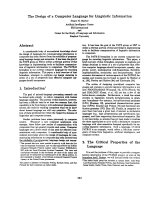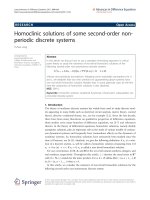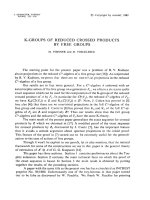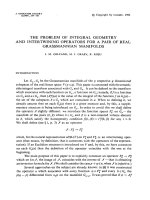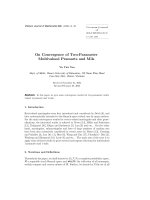Báo cáo toán học: "Combinatorial proof of a curious q-binomial coefficient identit" ppt
Bạn đang xem bản rút gọn của tài liệu. Xem và tải ngay bản đầy đủ của tài liệu tại đây (92.25 KB, 6 trang )
Combinatorial proof of a curious
q-binomial coefficient identity
Victor J. W. Guo
a
and Jiang Zeng
b
a
Department of Mathematics, East China Normal University,
Shanghai 200062, People’s Republic of China
, />b
Universit´e de Lyon; Universit´e Lyon 1; Institut Camille Jordan, UMR 5208 du CNRS;
43, boulevard du 11 novembre 1918, F-69622 Villeurbanne Cedex, France
, />Submitted: Sep 18, 2009; Accepted: Feb 2, 2010; Published: Feb 8, 2010
Mathematics Subject Classifications: 05A17, 05A30
Abstract
Using the Algorithm Z developed by Zeilberger, we give a combinatorial proof
of the following q-binomial coefficient identity
m
k=0
(−1)
m−k
m
k
n + k
a
(−xq
a
; q)
n+k−a
q
(
k+1
2
)
−mk+
(
a
2
)
=
n
k=0
n
k
m + k
a
x
m+k− a
q
mn+
(
k
2
)
,
which was obtained by Hou and Zeng [Europ ean J. Combin. 28 (2007), 214–227].
1 Introduction
Binomial coefficient identities continue to attract the interests of combinatorists and com-
puter scientists. As shown in [7, p. 2 18], differentiating the simple identity
km
m + r
k
x
k
y
m−k
=
km
−r
k
(−x)
k
(x + y)
m−k
n times with respect to y, and then replacing k by m − n − k, we immediately get the
curious binomial coefficient identity:
k0
m + r
m − n − k
n + k
n
x
m−n−k
y
k
=
k0
−r
m − n − k
n + k
n
(−x)
m−n−k
(x + y)
k
.
(1)
the electronic journal of combinatorics 17 (2010), #N13 1
Identity (1) has been rediscovered by several authors in the last years. Indeed, Simons
[13] reproved the following special case of (1):
n
k=0
(−1)
n−k
n
k
n + k
k
(1 + x)
k
=
n
k=0
n
k
n + k
k
x
k
. (2)
Several different proofs of (2) were soon given by Hirschhorn [8], Chapman [4], Prodinger
[11], and Wang and Sun [15]. As a key lemma in [14, Lemma 3.1], Sun proved the following
identity:
m
k=0
(−1)
m−k
m
k
n + k
a
(1 + x)
n+k−a
=
n
k=0
n
k
m + k
a
x
m+k− a
. (3)
Finally, by using the method of Prodinger [11], Munarini [10] generalized (2) to
n
k=0
(−1)
n−k
β − α + n
n − k
β + k
k
(1 + x)
k
=
n
k=0
α
n − k
β + k
k
x
k
. (4)
The identities (1), (3) and (4) are obviously equivalent. Recently, an elegant combinatorial
proof of (4) was given by Shattuck [12], and a little complicated combinatorial proof of
(2) was provided by Chen and Pang [5].
On the other hand, as a q- analogue of Sun’s identity (3), Hou and Zeng [9, (20)] proved
the following q-identity:
m
k=0
(−1)
m−k
m
k
n + k
r
(−xq
r
; q)
n+k−r
q
(
k+1
2
)
−mk+
(
r
2
)
=
n
k=0
n
k
m + k
r
x
m+k− r
q
mn+
(
k
2
)
, (5)
where the q-shifted factorial is defined by (a; q)
n
= (1 − a)(1 − aq) · · · (1 − aq
n−1
) and the
q-binomial coefficient
α
k
is defined as
α
k
=
(q
α−k +1
; q)
k
(q; q)
k
, if k 0,
0, if k < 0 .
Note that, rewriting (5) as
n
k=0
(−1)
n−k
β − α + n
n − k
β + k
k
q
(
n−k
2
)
−
(
n
2
)
(−xq
β
; q)
k
=
n
k=0
α
n − k
β + k
k
q
(
n−k+1
2
)
−(n−k)α+nβ
x
k
,
we obtain a q-analogue o f (4).
In this paper, motivated by the two aforementioned combinatorial proofs for q = 1, we
propose a combinatorial proof of (5) within the framework of partition theory by applying
an algorithm due to Zeilberger [3].
the electronic journal of combinatorics 17 (2010), #N13 2
2 The interpretation of (5) in partitions
A partition λ is defined as a finite sequence of nonnegative integers (λ
1
, λ
2
, . . . , λ
m
) in
decreasing order λ
1
λ
2
· · · λ
m
. Each nonzero λ
i
is called a part of λ. The number
and sum of part s of λ are denoted by ℓ(λ) and |λ|, respectively.
Recall [1, Theorem 3.1] that
n + k
r
=
ℓ(λ)r
λ
1
n+k −r
q
|λ|
. (6)
Therefore
m
k
q
(
k+1
2
)
−mk
= q
(
k+1
2
)
−mk
ℓ(λ)k
λ
1
m−k
q
|λ|
=
m−1µ
1
>···>µ
k
0
q
−|µ|
,
where µ
i
= m − i − λ
k−i+1
(1 i k). Moreover, t he coefficient of x
s
in (−xq
r
; q)
n+k−r
is equal to
n+k−1λ
1
>···>λ
s
r
q
|λ|
= q
(
s
2
)
+rs
ℓ(ν)s
ν
1
n+k −r−s
q
|ν|
,
where ν
i
= λ
i
− r − s + i (0 i s). It follows that the coefficient of x
s
in the left-hand
side of (5) is given by
q
(
r
2
)
+
(
s
2
)
+rs
m
k=0
(−1)
m−k
m−1µ
1
>···>µ
k
0
ℓ(λ)r
λ
1
n+k −r
ℓ(ν)s
ν
1
n+k −r−s
q
|λ|+|ν|−|µ|
. (7)
Now we need t o prove the following relation
ℓ(λ)r
λ
1
n+k −r
ℓ(ν)s
ν
1
n+k −r−s
q
|λ|+|ν|
=
ℓ(λ)r+s
λ
1
n+k −r−s
ℓ(ν)r
ν
1
s
q
|λ|+|ν|
. (8)
In view of (6), the last identity is equiva lent to
n + k
r
n + k − r
s
=
n + k
r + s
r + s
r
. (9)
Zeilberger [3] gave a bijective proof of (9) using t he partition interpretation (8). This
bijection is then called Algorithm Z (see also [2]). For reader’s convenience, we include a
brief description of this alg orithm. Note that Fu [6] also used this algorithm in her recent
study of the Lebesgue identity.
the electronic journal of combinatorics 17 (2010), #N13 3
3 Algorithm Z
For simplicity, performing parameter replacements n + k − r − s → t and ν → µ, we can
rewrite (8 ) as follows:
ℓ(λ)r
λ
1
s+t
ℓ(µ)s
µ
1
t
q
|λ|+|µ|
=
ℓ(λ)r+s
λ
1
t
ℓ(µ)r
µ
1
s
q
|λ|+|µ|
.
The Algorithm Z constructs a bijection between pairs of partitions (λ, µ) and (λ
′
, µ
′
) with
zeros permitted, satisfying
(i) λ has r + s parts, all t,
(ii) µ has r parts, all s,
(iii) λ
′
has s parts, a ll t,
(iv) µ
′
has r parts, all s + t,
(v) |λ| + |µ| = |λ
′
| + |µ
′
|.
Here is a brief description of this algorithm. Let λ = (λ
1
, . . . , λ
r+s
) and µ = (µ
1
, . . . , µ
r
)
be two partitions with λ
1
t and µ
1
s. For 1 i r, place µ
i
under λ
s−µ
i
+i
. Note
that 1 s − µ
i
+ i r + s and if i = j then s − µ
i
+ i = s − µ
j
+ j . The parts from λ
with nothing below form a new partition λ
′
. It is clear that λ
′
has s parts, all less than or
equal to t. Each of the ot her parts fr om λ is added to t he parts from µ which lies below
it, yielding a part in µ
′
. Note that µ
′
has r parts, all less than or equal to s + t.
For instance, let r = 6, s = 4, t = 10, and let λ = (9, 8, 7, 7, 6, 6, 6, 4, 2, 0) and
µ = (4, 2, 2, 1, 1, 0), then λ
′
= (8, 7, 6, 2) and µ
′
= (13, 9, 8, 7, 5, 0).
8 7 6 2 λ
′
λ 9 8 7 7 6 6 6 4 2 0
µ 4 2 2 1 1 0
13 9 8 7 5 0 µ
′
The algorithm is clearly reversible. Let λ
′
= (a
1
, . . . , a
s
) and µ
′
= (b
1
, . . . , b
r
). If
b
1
a
s
, then λ = (a
1
, . . . , a
s
, b
1
, . . . , b
r
) and µ = (0, . . . , 0). Otherwise, for any b
k
> a
s
,
we take the smallest i
k
1 such that b
k
− i
k
a
s−i
k
(a
0
= +∞) and b
k
− i
k
becomes a
part of λ and i
k
becomes a positive part of µ.
4 The proof of (5)
By the inverse of Algor ithm Z, the relation (8) holds and therefore (7) may be rewritten
as
q
(
r+s
2
)
m
k=0
(−1)
m−k
m−1µ
1
>···>µ
k
0
ℓ(λ)r+s
λ
1
n+k −r−s
ℓ(ν)r
ν
1
s
q
|λ|+|ν|−|µ|
. (10)
the electronic journal of combinatorics 17 (2010), #N13 4
For any pair (µ; λ) = (µ
1
, . . . , µ
k
; λ
1
, . . . , λ
r+s
) such that m − 1 µ
1
> · · · > µ
k
0 a nd
n + k − r − s λ
1
· · · λ
r+s
0, we construct a new pair (µ
′
; λ
′
) as follows:
• If µ
k
> 0 or µ = ∅, then µ
′
= (µ
1
, . . . , µ
k
, 0) and λ
′
= λ;
• If µ
k
= 0 and λ
1
< n + k − r − s, then µ
′
= (µ
1
, . . . , µ
k−1
) and λ
′
= λ;
• If µ
k
= 0 and λ
1
= n+k −r−s, we choose the largest i and j such that µ
k+1−i
= i−1
and λ
j
= λ
1
. If i j and i m − 1, then let
µ
′
= (µ
1
, . . . , µ
k−i
, i, µ
k+1−i
, . . . , µ
k
) and λ
′
= (λ
1
+ 1, . . . , λ
i
+ 1, λ
i+1
, . . . , λ
r+s
).
If i > j, then let
µ
′
= (µ
1
, . . . , µ
k−j−1
, µ
k+1−j
, . . . , µ
k
) and λ
′
= (λ
1
−1, . . . , λ
j
−1, λ
j+1
, . . . , λ
r+s
).
Note that |λ| − |µ | = |λ
′
| − |µ
′
| and the lengths of µ and µ
′
differ by 1. It is easy to see
that the mapping (µ; λ) → (µ
′
; λ
′
) is a weight-preserving-sign-reversing invo l ution. Only
the pairs (µ; λ) such that µ = (m − 1, m − 2, . . . , 1, 0), r + s m and λ
1
= · · · = λ
m
=
n +m −r −s will survive. That is to say, the expression (10) is equal to 0 if r +s m− 1,
and
q
(
r+s
2
)
ℓ(λ)r+s−m
λ
1
n+m−r−s
ℓ(ν)r
ν
1
s
q
|λ|+m(n+m−r−s)+|ν|−
(
m
2
)
if r + s m, (11)
namely
n
r + s − m
r + s
r
q
mn+
(
r+s−m
2
)
,
which is the coefficient of x
s
in the right-hand side of (5). This completes the proof.
Acknowledgments. This work was partially supported by the project MIRA 2008 of
R´egion Rhˆone-Alpes. The first author was sponsored by Shanghai Educational D evel-
opment Foundation under the Chenguang Project (#2007CG29), Shanghai Rising-Star
Program (#09QA1401700), Shanghai Leading Academic Discipline Project (#B407), and
the National Science Foundation of China (#10801054) .
References
[1] G. E. Andrews, The Theory of Partitions, Cambridge University Press, Cambridge,
1998.
[2] G. E. Andrews a nd D . M. Bressoud, Identities in combinatorics, III, Further aspects
of ordered set sorting, Discrete Math. 49 (1984), 223–236 .
[3] D. M. Bressoud and D. Zeilberger, Generalized Rogers-Ramanujan bijections, Adv.
Math. 78 (1989), 42–75.
the electronic journal of combinatorics 17 (2010), #N13 5
[4] R. Chapman, A curious identity revisited, Math. Gazette 87 (2003), 139–141.
[5] W. Y. C. Chen and S. X. M. Pang, On the combinatorics of the Pfaff identity, Discrete
Math. 309 (2009), 2 190–2196.
[6] A. M. Fu, A combinatorial proof of the Lebesgue identity, Discrete Math. 308 (2008),
2611–2613.
[7] R. L. Graham, D. E. Knuth and O. Patashnik, Concrete Mathematics, Addison-
Wesley Pubilshing Co., 1989.
[8] M. Hirschhorn, Comment on a curious identity, Math. Gazette 87 (2003), 528–530.
[9] S. J. X. Hou and J. Zeng, A q-analog of dual sequences with applications, European
J. Combin. 28 (2007), 214–227.
[10] E. Munarini, Generalization of a binomial identity of Simons, Integers 5 (2005),
#A15.
[11] H. Prodinger, A curious identity proved by Cauchy’s integral formula, Math. Gazette
89 (200 5), 266–267.
[12] M. Shattuck, Combinatorial proofs of some Simons-type binomial coefficient identi-
ties, Integers 7 (2007), #A27.
[13] S. Simons, A curious identity, Math. Gazette 85 (2001), 296 –298.
[14] Z W. Sun, Combinatorial identities in dual sequences, European J. Combin. 24
(2003), 709–718.
[15] X. Wang and Y. Sun, A new proof of a curious identity, Math. Gazette 91 (2007),
105–106.
the electronic journal of combinatorics 17 (2010), #N13 6

